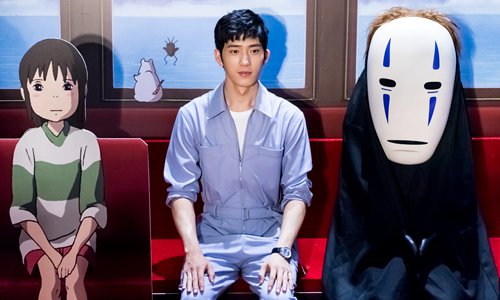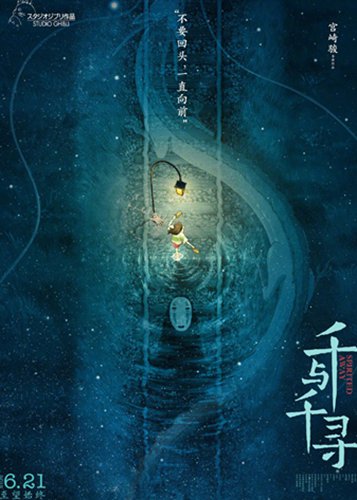HOME >> ARTS
Graphic artist Huang Hai strikes again with ‘Spirited Away’ posters
By Chen Xi Source:Global Times Published: 2019/6/23 17:54:37

Chinese actor Jing Boran poses for a picture with characters from the Spirited Away film Photo: IC

A poster for Spirited Away designed by Huang Hai Photo: IC
"Don't look back, keep moving forward."
Under these words, Chihiro Ogino, the main character from the famous Japanese animated movie Spirited Away, walks barefoot down a railroad track covered in water. To her front left, the warm glow of a street lamp lights up the water, where the reflections of the white dragon Haku, a faceless man with a black body known as No-Face and a dark blue galaxy full of little twinkling stars can be seen around her.
"What a marvelous poster! It invokes the beautiful memory of watching Spirited Away for the first time. These excellent posters made me want to watch the movie again," Wu Qi, a freelancer living in Shanghai and a fan of the film, told the Global Times.
The Chinese posters for Spirited Away won a flood of praise in China and abroad during the run up to the movie's Chinese mainland debut on Friday, causing poster designer Huang Hai to once again become the center of discussion. Some are describing his success with this and other posters for major films as "the rise of the Chinese designer."
Road to success
Born in East China's Fujian Province, Huang gained an interest in painting as a child. Interestingly enough, although he graduated from the Art College of Xiamen University. Huang's first job found him not working as an artist, but as a social journalist at a TV station.
The job still had a major impact on his life as it raised his awareness on social issues. His third year on the job, he decided he wanted more.
Huang entered a training program in Beijing run by the British advertising company Ogilvy, which is based in New York. His teacher, a respected designer from Taiwan, provided him a lot of guidance.
The high-intensity speed of the program did not exhaust Huang in the slightest. On the contrary, he found everything very exciting and eagerly tried to learn all he could. This experience opened up a broader creative vision for his future poster designs.
"Advertising is the combination of creativity and business. The difficulty of advertising is how to get to people's hearts. Touching people's hearts is the core and the essence of a successful advertisement, which is the focus of my design," said Huang in a report by tmtpost.com in 2015.
After finishing the Ogilvy training program, Huang went to work as an art director at a domestic Chinese company. One day he was tasked with designing the poster for Chinese film director Jiang Wen's movie The Sun Also Rises. At the time, Huang had no idea how this would change the trajectory of his life. "I did not have any concerns because I had never done a movie poster before. I just felt it was fun," Huang said. After many proposals and drafts, the posters for The Sun Also Rises finally debuted at the Cannes Film Festival, where they received unanimous praise.
New adventure
The success of his first poster gave Huang the motivation to embark on a new career adventure.
"I had engaged in advertising for many years, but I felt that designing posters is much more fun than advertisements. I enjoyed the process of creation and rediscovered that feeling I had when I was in college," he said.
Three years ago, Huang founded the Zhuyewenhua studio, or the "Bamboo Art Studio." Huang said he chose bamboo to represent his new business because of its symbolic connotations in Chinese culture, such as the plant's straightness representing uprightness. Additionally, the name of the studio sounds similar to the Chinese word for "enough," which is a reminder for him to be modest.
Huang said that he feels very fortunate.
"Three years ago, I didn't expect my career would become so full of life. It has been like a big wave, pushing the development of the industry," he noted in the report.
While many in the film industry are busy pursuing stardom, Huang's attitude has remained simple. He said one of the industry's charms is that everyone, including actors, film directors and scriptwriters, has a valuable role to play, but not everyone has to be in the spotlight.
Window into a world
"Each movie is a world, and a poster is a window to see into that world. But if it's just a picture that lacks any content, it won't entice people to see the film," said Huang.
"'Simple but creative and powerful,' this is Huang's unique style of design," Shi Wenxue, a film critic based in Beijing, told the Global Times.
"Huang's posters are not abstract or complicated. The posters catch your eye and touch your heart at the glance because the main body is outstanding and all the elements are from the movie," Shi explained, pointing to another of Huang's Spirited Away posters as an example. The poster shows the character of Chihiro Ogino crouched down and hugging herself in front of a wall painted with various characters from the film, including a large version of herself. The viewpoint makes it seem as if the larger version of herself is reaching out and comforting the small kneeling girl. In the middle of the poster are the words "Do not lose yourself" in Chinese, emphasizing the theme of the movie.
"I really like Huang's design because he puts many Chinese elements into his work. I started to be his fan after I saw his posters for Stand by Me Doraemon, one of my favorite Japanese animated movies. Huang designed Doraemon as the Monkey King in Journey to the West, which is quite impressive because the Monkey King also has many magic skills like Doraemon," Song Chenwei, an animation designer, told the Global Times.
Newspaper headline: Rise of Chinese design
Posted in: FILM,CULTURE & LEISURE